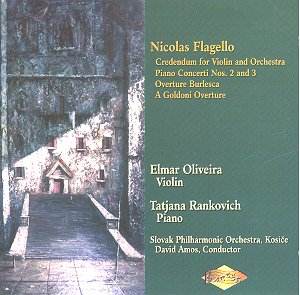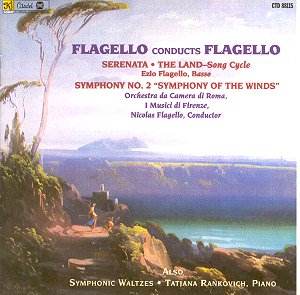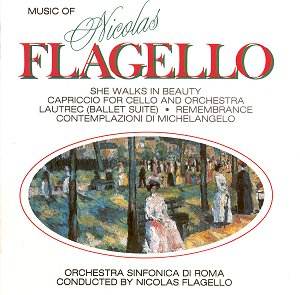A TRIO OF CDs: THE MUSIC OF NICOLAS FLAGELLO
THE UNREGARDED AMERICAN ROMANTIC
NICOLAS FLAGELLO (1928-1994)
Flagello's music has been equated with that of Mahler, Puccini and Rachmaninov.
These parallels are not hard to follow when you are in the presence of the
music.
He was born in New York, of Italian extraction, and from a musical family.
His younger brother, Ezio, was a famous bass who sang often at the Met.
After leaving High School he joined the All-American Youth Orchestra and
played under Stokowski during his post-Philadelphia nomadic years. He studied
at the Manhattan School of Music with Harold Bauer and Vittorio Giannini.
His strongest link was with Giannini with whom he studied for 15 years from
1935. In the late 1940s he studied conducting with Mitropoulos.
NICOLAS FLAGELLO
(1928-1994)
Overture Burlesca (1952)
Piano Concerto No 2 (1956)
Credendum for violin and orchestra (1973)
A Goldoni Overture (1967)
Piano Concerto No 3
(1959)
 Tatjana Rankovich
(piano)
Tatjana Rankovich
(piano)
Elmar Oliveira (violin)
Slovak PO/David Amos
rec Kosice June 1995
 ARTEK AR-0002-2 [67.44]
ARTEK AR-0002-2 [67.44]
Crotchet
Artek

Flagello's part in the 'Italian stream' in American classical music has received
scant attention. He is a New Yorker through and through but a Puccinian passion
dominates rather than jazz, the blues or sardonic frivolity.
Mention of verismo operatic high jinks may be misleading. There is a touch
of 'blood and thunder' but the 'bel canto' strain is more relevant. So it
is a case of less Puccini and more early Malipiero, Respighi and Martucci.
Credendum while essentially a singing work is a 'frosted glass'. If
you know the Arthur Bliss Violin Concerto in its less exuberant episodes
you will know what to expect. It is a matter of accent. The voice, though,
is still locked deep in the bedrock of romantic tonality. Credendum
(like the identically named orchestral work by William Schuman) refers to
a statement of faith and this is a serious work of reflection with some rolling
horn-lofted climaxes recalling the Aulis Sallinen First Symphony. If the
cradled tenderness of the Walton and Barber violin concertos hits you towards
the end (11.03) the soft gong strokes at the close provide an 'earth' for
the gleamingly spun introspection of the violin in the closing measures.
The Goldoni Overture written as a 'vorspiel' to Giannini's final opera
is not entirely the 'glitter and skitter' item you might have expected. Howard
Hanson is a beneficent influence on the brass writing. The work has some
of the zippy levity of Walton's Portsmouth Point - a character it
shares with the Overture Burlesca which launches like an emotionally
clipped version of the scherzo of the Moeran symphony.
As the notes point out, the Third Piano Concerto is separated from No 2 by
a decade. It is a steelier statement but the shapely grandeur of the climax
at 7.10 leaves us in no doubt of Flagello's allegiance to the romantic impulse
also much in evidence in the guileless slightly doom-ridden peak of the middle
movement. With its tubular bells the movement strikes a note familiar from
Alwyn's Symphony No. 5 Hydriotaphia - all cortège, funereal
triumph and Sibelian resolve. The granitic finale lacks articulation. Its
ghoulish mesmerising tone is straight out of Liszt's Totentanz and
Herrmann's Concerto Macabre.
The earlier piano concerto splices the heroics of the Arthur Bliss Piano
Concerto with a Prokofievian élan. There is a frank tuneful impulse
at work among the soliloquising and the barn-storming crescendi. I can imagine
Flagello having enjoyed the Bortkiewicz Piano Concertos 2 and 3 as much as
Bortkiewicz might have enjoyed Flagello's. Rachmaninov was also an influence
- listen to 4.48 in the allegro giusto. In the second movement we
encounter cooling and leaf-touched woodwind writing with the eerie bell tones
of Shostakovich's Second Piano Concerto. Blissy heroism, now sulphur-dosed,
rears up again for the finale. As in the earlier concerto Rankovitch is beyond
negative criticism though the orchestra's intonation is sometimes, at the
very least, suspect.
Now Artek, let's have the first and fourth concertos on a single disc and
with Rankovich as the soloist.
A strong recommendation for anyone who, having started exploration with the
Naxos American Classics series, would like to delve deeper into
20th Century Romantic Americana.
Rob Barnett

NICOLAS FLAGELLO
(1928-1994)
Serenata (1968)
The Land - song cycle (1954)
Symphony No. 2 Symphony of the Winds
(1970)
Symphonic Waltzes for solo piano
(1958)
 Ezio Flagello (bass)
Ezio Flagello (bass)
Tatjana Rankovich (solo piano)
Orchestra da Camera di Roma/Nicolas Flagello
I Musici di Firenze/Nicolas Flagello
rec Serenata (Rome 1968); The Land (1962), Symphony (1979), Waltzes
(12/7/1994)
 CITADEL CTD 88115
[74.38]
CITADEL CTD 88115
[74.38]
Crotchet
Amazon
US

Citadel are one of those 'obscure' labels that lack a high or even middling
profile. They have a decent website but, like Phoenix and Artek (both of
which have websites and each of which has a single Flagello CD in their lists),
they remain determinedly modest about their strong catalogue. That they have
Tom Null as their producer is a mark of their quiet and competent distinction.
Their flair for non-obvious but adventurously rewarding repertoire is patent
from their catalogue.
The Serenata for small orchestra was composed in Rome. It is an archetype
of post-modern romanticism. In the Psalmus its warm and floating Delian
susurration melts into music recalling Barber (minus the angst) and Howard
Hanson not to mention the famous Bruch violin concerto. A total change of
mood in the second movement moves into Pulcinella world - anxious, oleaginous,
lickerishly rhythmic. Before the hectic, carefree, fast-striding skip of
the finale we progress through the music of epic poetry. This music reminded
me of the work of Lopes-Graca which I reviewed on a number of Portusom CDs
a couple of months ago.
The Land (not to be confused with Maconchy's orchestral suite) is
a song cycle with orchestra in which the composer's brother is the singer.
The poems are by Alfred, Lord Tennyson. They progress through the Dickensian
alley-fog of The Eagle to the Britten and (Geoffrey!) Bush inflected
The Throstle to the Petrushka-like exultation and
Abschied of The Oak, the nativity celebration of The Snowdrop
and the stertorous bells of Flower in the Cranny.
In 1979 Marice Stith conducted the Cornell Wind Ensemble in the premiere
of Symphony of the Winds. I would have liked to have had Flagello's
Symphony No. 1 on this disc as well. I know the First Symphony (1968) from
a radio tape of the composer conducting the Manhattan SO. That first symphony
is a work of electric atmosphere: tragic and heroic as the liner notes indicate.
The second symphony is an importunate, angst-ridden and gloomy carousel charged
with aggressive vitality and framing a central movement which does not travel
hopefully.
Rankovich, who has already recorded a very fine anthology of piano works
by Creston, Giannini and Flagello on Phoenix (reviewed elsewhere on this
site), unites two of the three Flagello CDs. These waltzes are a version
of the suite we know as the Lautrec Suite (included in orchestral
form on the Phoenix disc). They evoke turn of the century Paris: dangerous
and romantic in equal measure. The first waltz is influenced by Prokofiev
and Rachmaninov - a swirling exhalation of notes - while the second is a
'valse triste' rising to a stormily aristocratic statement. Rankovitch despatches
the final 'psychological' waltz in the adept and exciting style we fully
expect from her performances of the two piano concertos.
Citadel valuably and generously contribute to the small Flagello discography.
I hope they can sort out a tape of the First Symphony and Missa Sinfonica
at some point and perhaps couple these with several Giannini symphonies
(not No. 3) or his Psalm 130 for cello and orchestra.
Rob Barnett

Jabberwocky Productions e-mail:
jabwocky@aol.com
P O Box 3269
http://members.aol.com/jabwocky
Santa Monica, CA 90408 FAX: (310) 829-9447
NICOLAS FLAGELLO
(1928-1994)
She Walks in Beauty (1957)
Capriccio for cello and orchestra (1962)
Lautrec - Ballet suite
(1965)
Remembrance (1971)
Contemplazioni Michelangelo
(1964)
 George Koutzen - cello
George Koutzen - cello
Joann Grillo - soprano (She Walks)
Maya Randolph - soprano (Remembrance)
Nancy Tatum - soprano (Contemplazioni)
Orchestra Sinfonica di Roma/Nicolas Flagello
rec 1960s and 1970s?
 PHOENIX PHCD 125
[65.51]
PHOENIX PHCD 125
[65.51]
Amazon
US

What is it about Byron's poem 'She Walks in Beauty'? It clearly touched off
emotionally direct responses in both Otto Luening and Nicolas Flagello. Luening's
setting (in the recent and very fine
collection of Luening and Starer
songs on Parnassus) is hymn-like and folksy - rather like a homely sampler
(think also of Leo Smit's Dickinson songs on Bridge). Flagello's is luxurious;
a Rodgers and Hammerstein treatment (think of the song 'Out of my heart and
into your dreams') touched with the grand operatic air of Barber's
Vanessa. A little winner!
From a truly beautiful song we move into darker oceans with Capriccio.
Devotees of the Walton Cello Concerto, Rubbra Soliloquy and Sibelius's
Fourth Symphony will know what to expect. Flagello walks along the shores
of the same desolate lake favoured by Warlock and van Dieren. While the line
between profound and gloomy can be difficult to discern Flagello treads it
like a master. You can cut the atmosphere with a very broad shovel. The jagged
shrieks of the orchestra at 3.33 recalls the Bloch of Schelomo but
this is a distinctive work of great power - Flagello has his own voice. The
statement at 13.43 is one of major lyrical eminence. A work of extraordinary
grip.
After all this tension the suite provides some relief but by no means as
much as you might expect. It shimmers darkly, waltzing and spinning; at times
the echo of a screeching carousel; at others redolent of the Tunisian vocal
tradition beloved of Peggy Glanville-Hicks. One wonders if Flagello is one
of those composers who have inspired Sondheim in his waltz-haunted masterworks
of twentieth century musical theatre. The Moulin Rouge track is a
tenebrous 'valse lugubre' - anxious, desperate, choleric and tracing its
lineage to Ravel's La Valse.
Remembrance is suitably nostalgic and wonderfully presented by Maya Randolph.
The twining flute line nicely sets off Randolph's unstrained high notes.
Nancy Tatum is in less healthy voice for the Michelangelo Contemplations
and while the last song is charged with truculent vitality the remainder
do not register strongly.
All texts are printed in the booklet.
This disc, which has been around since 1991, is highly desirable for the
first three works on the disc. In many ways this is the place to start for
Flagello initiates who favour the vocal tradition.
Rob Barnett

www.phoenixcd.com
Phoenix USA
200 Winston Drive - Cliffside Park - New Jersey 07010
Phone: 201 224-8318 Fax: 201 224-7968 E-Mail: Sales@Phoenixcd.com

